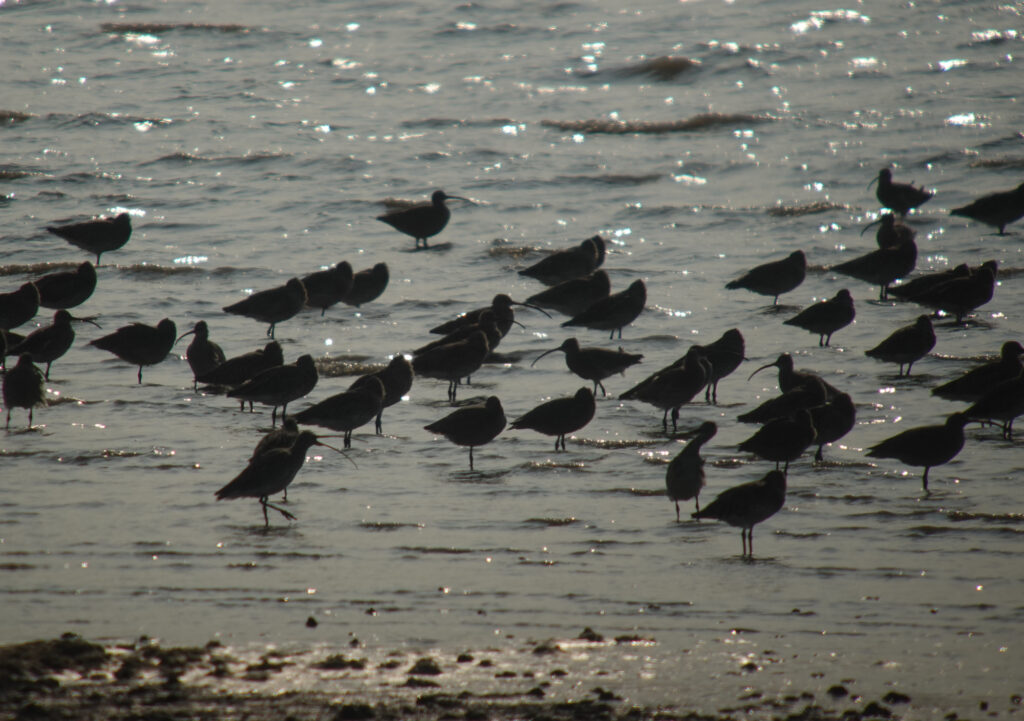Bird News from Dr Nial Moores with Dr Mark Harris, Birds Korean Jung Hancheul (on 27th), multiple Birds Koreans (on 28th) and Birds Korea Yeoncheon Director Baek Seung-Kwang (on 29th).
Three days looking through some spectacular concentrations of birds, with a total of 136 species logged, including a Bar-headed Goose, a Blue morph Snow Goose, and a dozen globally threatened or Near Threatened bird species.
Starting before sunrise at the Hwaseong Wetlands on 27th, we soon found an adult Lesser White-fronted Goose and Snow Goose among a mass of an estimated 30,000 Tundra Bean and 8,000 Greater White-fronteds; followed soon after by four globally Endangered Oriental Stork (at least one of which was unringed); 120+ globally Endangered Black-faced Spoonbill; and a good diversity of ducks and shorebirds, including Baikal Teal, c. 50 globally Endangered Far Eastern and c. 2,200 globally Near Threatened Eurasian Curlew, small groups of globally Vulnerable Saunders’s Gull, 48 lingering globally Endangered Great Knot, 28 Black-tailed Godwit and a total of 35-50 Marsh Sandpiper – a high and late number of this generally scarce species here in Korea.





See the full checklists on eBird here , here, here and here.
On 28th, the day at Seosan Lake A again started before sunrise, with first highlight a River Otter followed soon after by a Ruddy-breasted Crake, set against a cacophony of geese out on the reclamation lake in the fog. As the fog thinned and the sun broke through, wave after wave of geese exploded out from roost, allowing the first of 7-10 globally Vulnerable Lesser White-fronted Goose seen (and / or heard) during the day to be picked out more easily from the mass; and a small number of Whooper Swan. In rice-fields, we saw several small groups of globally Vulnerable Hooded Crane in flight, apparently in active migration to or through the site, and a flock of 40 globally Near Threatened Northern Lapwing, but remarkably few other birds of note – with best a few globally Vulnerable Rustic Bunting and a single Upland Buzzard. Toward the south end of the reclamation lake, after a few hours of feeding in rice-fields, at least 125,000 geese were back on the lake, estimated in a single scan in thousand blocks, with another 30,000 (?) or so too far away to count in the southwest of the lake. Here, as a group of Birds Koreans (including Subhojit Chakladar who kindly contributed one of his images to this post) scanned the mass of geese, we picked out first an adult Snow Goose, followed soon after by a globally Vulnerable Swan Goose and then a Bar-headed Goose – the latter species present here since at least September 30th based on Facebook posts. There is no rarities committee here; and no formal national organisation of records, but the species is now reported annually, and this is probably about the 15th to 20th Korean record of Bar-headed Goose after the first found by Dr Lee Kisup in the Han Imjin River Estuary back on March 15th 2003.
A search in the southwest – in part in our failed effort to find a Red-breasted Goose which was seen daily at Seosan between October 9th and 12th – found yet more massive concentrations of geese, including another adult white morph Snow Goose; and then in the northwest, a stunning Blue Morph Snow Goose – my personal first in Korea (or perhaps anywhere in the wild?). Although there have been some birds photographed in recent winters which showed some features of Blue Morph Snow Geese, up to now most (or all?) of these seem to have been assessed as hybrids (e.g., Snow x Tundra Bean or Greater White-fronted Goose). More blue morph Snow Geese can be expected in the future perhaps. According to a post on Fb by goose researcher Ikeuchi Toshio on October 29th, Blue morph Snow Geese were originally absent from breeding colonies of white morph Snow Goose on Wrangel Island; but white x blue pairs are now increasing in number there, after they formed breeding pairs in the wintering range in New Mexico.







See the full checklist on eBird here.
On 29th, after meeting up with Director Baek Seung-Kwang, we first visited the Peace Rice-fields in the CCZ in the Yeoncheon Imjin River Biosphere Reserve, which initially were densely draped in fog and had patches of frost, before the sun broke through and temperatures warmed rapidly. Highlights here included a close encounter with a lone globally Vulnerable White-naped Crane (the first of about 40 seen during the day) and a wonderful diversity of very hard-to-see landbirds, several of which are scarcely reported in inland counties, including two globally Near Threatened Ochre-rumped Bunting and two Siberian Rubythroat. Additional species of note here included multiple Eurasian Bullfinch, three Siberian Accentor and two Pallas’s Rosefinch all heard only (my personal first of the winter – though reported by others in and around Seoul).
From there, a survey of a restricted access stretch of the Imjin River discovered five globally Endangered Scaly-sided Merganser and a Merlin. The three days finished at the “Spoonbills project site” in Jeongok, where – in spite of very high levels of disturbance – we found 20 Long-billed Plover and our first Dunlin in Yeoncheon found during our survey work there which started in 2020.








